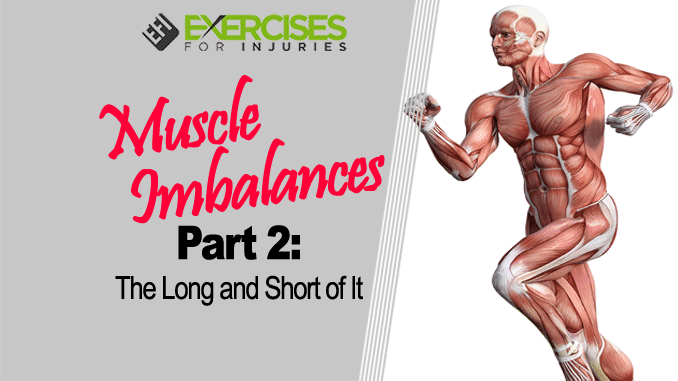It is important to be aware of muscle imbalances created by exercises that target one side of your body more than the other. These imbalances can lead to unwanted consequences such as injured joints, weaker muscles, and posture issues. After sending out the update on Muscle Imbalances Revealed 2.0, one of the contributors of MIR, Dean Somerset, sent me a great guest blog post for you.
Muscle Imbalances Part 2: The Long and Short of It
In the previous post, we looked at how a muscle can become overactive to compensate for a reduction in a function somewhere else in the body.
Weak ankles can cause tight hip flexors by altering the normal movement of the joint. To correct the problem, you need to strengthen the ankle.
Many people held to this concept with dismay that stretching tight muscles would not allow that muscle to lengthen!! For this post, we will look at another classic muscle imbalance and overactive fatigue, the hamstrings.
The 3 Hams
The three hamstring muscles cause knee flexion and hip extension. When activated on the medial or lateral aspect, they can cause tibial and hip rotation. They have a big role in the health of the back, hips, and knees.es.
Tight hamstrings are a hallmark symptom of low back pain. It’s unclear whether tight hamstrings cause low back pain or the low back pain results in tight hamstrings.
Office workers tend to have a kyphotic posture that gets worse over time due to a loss of lumbar extension, tilting of the pelvis, and shortening of the hamstrings. To provide stability and prevent back pain, the hamstrings tense up and pull the back into a rigid, immobile structure.
What is the solution?
Stretch the tired hammies that are only trying to keep the place together?
If we stretch them now, the back will lose stability, and injury to the rear will likely occur. This would be like taking structural supports away from a dam and hoping we have enough towels to clean up the mess afterward.
With most back injuries, the significant range of motion lost is a spinal extension. The hip flexor becomes the major muscle capable of causing spinal extension. The hamstrings will pull the pelvis into a posterior tilt, which pressurizes the discs and creates an imbalance between forces pulling the vertebrae down onto the discs versus those that pull up on the vertebrae. This can lead to disc issues, soft tissue trauma, and a lack of leg and back strength.
Stretching Tight Hamstrings
The obvious answer to the query “Should we keep stretching those annoying tight hamstrings?” is “No, we should not.” A better strategy would be strengthening the backbone through active extension to strengthen its stability, relieve it of burden, relax, and allow it to stretch freely again.
For all the endurance athletes out there or the stair-masters/elliptical masters who can’t get their hamstrings to loosen after spending one or three hours on a stationary piece of cardio machinery, try getting a little extension in your back, and see what happens to your hammies. They may like it!!
It is Rick again. Dean was one of the significant contributors to MIR2. He has two excellent presentations on the fascia. If you are a trainer, coach, or therapist, I know they will help you.
Bottom line
Muscle imbalances are common among people who work out or have a history of misusing their bodies, including sitting, standing, and walking. If you notice any of the symptoms listed above, it’s best to seek out professional help to correct them. Keep your muscles balanced and strong to reduce your risk of injury and pain.
To check the presentations out, CLICK HERE.
Rick Kaselj, MS

